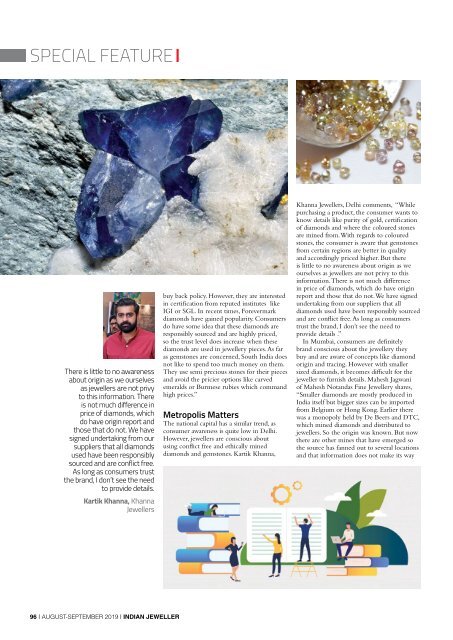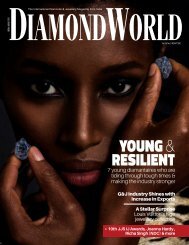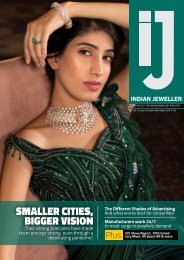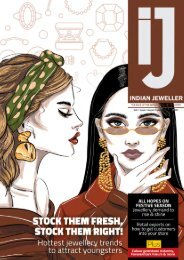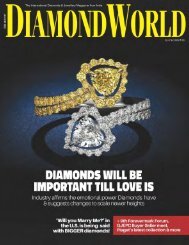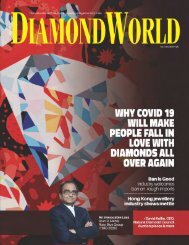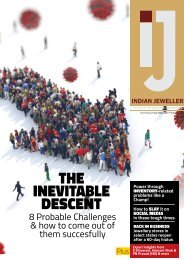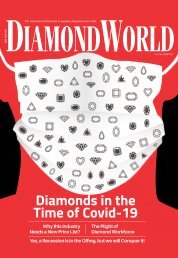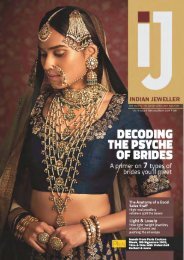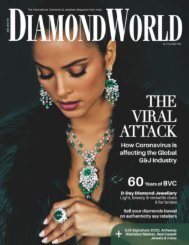Indian Jeweller (IJ) Magazine August -September 2019
Volume 10 | Issue 1 August September 2019
Volume 10 | Issue 1
August September 2019
Create successful ePaper yourself
Turn your PDF publications into a flip-book with our unique Google optimized e-Paper software.
Special Feature<br />
There is little to no awareness<br />
about origin as we ourselves<br />
as jewellers are not privy<br />
to this information. There<br />
is not much difference in<br />
price of diamonds, which<br />
do have origin report and<br />
those that do not. We have<br />
signed undertaking from our<br />
suppliers that all diamonds<br />
used have been responsibly<br />
sourced and are conflict free.<br />
As long as consumers trust<br />
the brand, I don’t see the need<br />
to provide details.<br />
Kartik Khanna, Khanna<br />
<strong>Jeweller</strong>s<br />
buy back policy. However, they are interested<br />
in certification from reputed institutes like<br />
IGI or SGL. In recent times, Forevermark<br />
diamonds have gained popularity. Consumers<br />
do have some idea that these diamonds are<br />
responsibly sourced and are highly priced,<br />
so the trust level does increase when these<br />
diamonds are used in jewellery pieces. As far<br />
as gemstones are concerned, South India does<br />
not like to spend too much money on them.<br />
They use semi precious stones for their pieces<br />
and avoid the pricier options like carved<br />
emeralds or Burmese rubies which command<br />
high prices.”<br />
Metropolis Matters<br />
The national capital has a similar trend, as<br />
consumer awareness is quite low in Delhi.<br />
However, jewellers are conscious about<br />
using conflict free and ethically mined<br />
diamonds and gemstones. Kartik Khanna,<br />
Khanna <strong>Jeweller</strong>s, Delhi comments, “While<br />
purchasing a product, the consumer wants to<br />
know details like purity of gold, certification<br />
of diamonds and where the coloured stones<br />
are mined from. With regards to coloured<br />
stones, the consumer is aware that gemstones<br />
from certain regions are better in quality<br />
and accordingly priced higher. But there<br />
is little to no awareness about origin as we<br />
ourselves as jewellers are not privy to this<br />
information. There is not much difference<br />
in price of diamonds, which do have origin<br />
report and those that do not. We have signed<br />
undertaking from our suppliers that all<br />
diamonds used have been responsibly sourced<br />
and are conflict free. As long as consumers<br />
trust the brand, I don’t see the need to<br />
provide details .”<br />
In Mumbai, consumers are definitely<br />
brand conscious about the jewellery they<br />
buy and are aware of concepts like diamond<br />
origin and tracing. However with smaller<br />
sized diamonds, it becomes difficult for the<br />
jeweller to furnish details. Mahesh Jagwani<br />
of Mahesh Notandas Fine <strong>Jeweller</strong>y shares,<br />
“Smaller diamonds are mostly produced in<br />
India itself but bigger sizes can be imported<br />
from Belgium or Hong Kong. Earlier there<br />
was a monopoly held by De Beers and DTC,<br />
which mined diamonds and distributed to<br />
jewellers. So the origin was known. But now<br />
there are other mines that have emerged so<br />
the source has fanned out to several locations<br />
and that information does not make its way<br />
96 | august-september <strong>2019</strong> | INDIAN JEWELLER


